“I couldn’t let the false accusations of one foolhardy man endanger the entire society of miniaturists.” (15)
The previous quote is from My Name is Red by Orhan Pamuk. In this book, each chapter is written, in turn, from the perspective of a different character.
Don’t you think it’s fair that everyone should have a voice?
I began thinking about this after plunging into the condensed writing of Homi K. Bhabha in his chapter The Location of Culture, which emphasizes the necessity for all voices to be heard. It is better to identify as a global citizen than as a national, and consider not just one voice, but all when considering one’s identity. Our history is not in the past as it is not static, but it is a story that is being written simultaneously by many. If our story were to be written in keeping with this theme, like in Orhan Pamuk’s My Name is Red, each character takes turn giving their account, and so the readers may see everything for themselves.
As this is often not the case, the unheard voices become liminal. A multitude of voices can be divided between the powerful and the oppressed. We can think of Freud’s model of the conscious and the unconscious when thinking of our nation state. This polarity exists until a temporal shift reigns; one which grounds us into the present moment, and this multiplicity of histories being written, right before our eyes.
So yes, this book of Orhan Pamuk’s quite impressed me with its multiple voices evenly shared. It also inspired me to go on and read more of his work, including Istanbul, a story of his city. 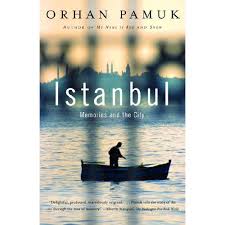 In turn, it made me want to go there.
In turn, it made me want to go there.
He wrote about the diamond-like sparkling of the Bhosphorus Strait through the middle of this city perched on the center of Europe 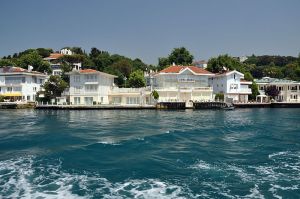 and Asia’s divide. He wrote how houses are pushed right up to the edge of this water, and how people prize living right on the edge, despite how boats sometimes crash through living room windows in storms.
and Asia’s divide. He wrote how houses are pushed right up to the edge of this water, and how people prize living right on the edge, despite how boats sometimes crash through living room windows in storms.
So by and by, I had to go see it for myself. We make decisions and plans evolve, but how is this? In Sheena Iyengar’s TED talk, The Art of Choosing http://www.ted.com/talks/sheena_iyengar_on_the_art_of_choosing?quote=785 she suggests that making choices is an art, and that when we are faced with a decision, it can be to our best advantage not to make that decision alone. I often travel alone and quite like it, for I find I am more open to meeting new people that way. However in this case, as I chatted about my plans and got excited over it, other voices got involved. At first, it was only me, but when two friends overheard my plans, then there were three. So with our collective and individual agendas together we traveled. 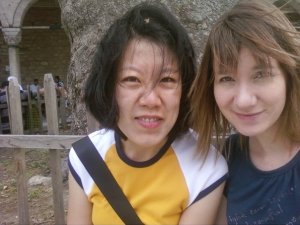
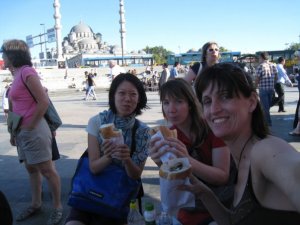
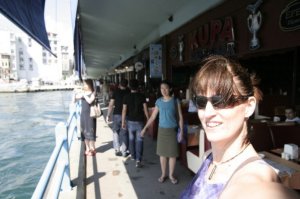
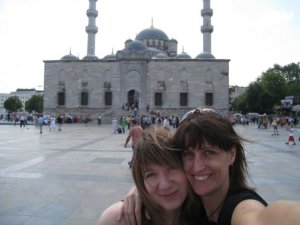 We all arrived at different times, and left at different times. I, being the greedy one, added Romania and Bulgaria into my trip as well, while my friends explored a bit out of the capital. But that is a story for another time.
We all arrived at different times, and left at different times. I, being the greedy one, added Romania and Bulgaria into my trip as well, while my friends explored a bit out of the capital. But that is a story for another time.
We combined our group wish list, including a Bosphorus boat tour, Topkapi Palace, the Blue Mosque, Dolmabahce Palace, and eating these kind of good/terrible fish sandwiches, from fish fished from the Bosphorus.
I am very spontaneous but not ambitious in building itineraries, so we were a great mix: synergy at it’s best. We got in enough sight-seeing, socializing with each other and with people we met, and I still made my train Bulgaria/Romania bound with more seconds to spare than when I plan on my own.
One must-see in Istanbul is the Hagia Sophia. (from the Greek: Ἁγία Σοφία, “Holy Wisdom“; Latin: Sancta Sophia or Sancta Sapientia; Turkish: Ayasofya)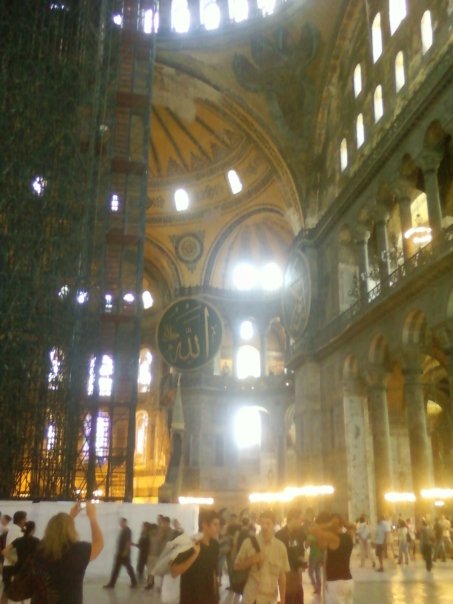 The Hagia Sophia was first a Greek orthodox basilica, later an Imperial mosque, and is now a museum. Let me remind you earlier I was talking about history. Not unlike Bhabha, David Spurr, in The Rhetoric of Empire, is quite concerned with attitudes that trample on with colonial, postcolonial, and imperial attitudes. I like to think of the Hagia Sophia as a beautiful example of how our constitutions morph, in the perspective of history. In Bhabha’s view, it is a church, a mosque, and a museum, all at once, whispering from the walls all the stories it has seen.
The Hagia Sophia was first a Greek orthodox basilica, later an Imperial mosque, and is now a museum. Let me remind you earlier I was talking about history. Not unlike Bhabha, David Spurr, in The Rhetoric of Empire, is quite concerned with attitudes that trample on with colonial, postcolonial, and imperial attitudes. I like to think of the Hagia Sophia as a beautiful example of how our constitutions morph, in the perspective of history. In Bhabha’s view, it is a church, a mosque, and a museum, all at once, whispering from the walls all the stories it has seen.
What stories would your walls tell if they could whisper?
In my next blog entry, I’ll be interviewing others and sharing their stories. Adieu.
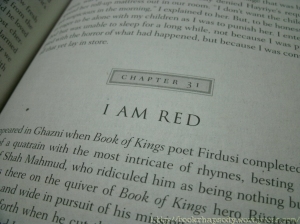
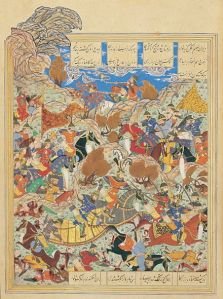
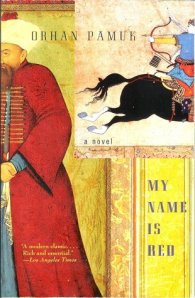
Rhea! What a wonderful idea to bring into your blog post the book, “My Name is Red” and tie in its interesting perspective of starting each chapter from a different perspective! By connecting the quote to Homi Bhabha and showcasing your travels, you have provided an in-depth example of the double-narrative!
Good question you have posed: What stories would your walls tell if they could whisper?
For me, I would like to think that my walls would tell about how hard I work to be a good wife and mom; or how dedicated I am to the education of myself and my girls; or how much I love to teach. But, I’m afraid the walls would whisper about how I don’t like to cook; or how I get so absorbed in my studies that I don’t listen to my girls! I’m content to let the walls be silent!!!
Kelly,
You are too funny. I know, right? I’m not sure how I’d really feel about talking walls. That would be a very good very surreal story idea.
Rhea
Rhea,
When you mention that reading Ohran Pamuk’s I Am Red inspired you to also read Istanbul and then you were determined to visit, I was reminded of Holland and Huggan’s comment in Tourists with Typewriters, that “travel books do not necessarily act as substitutes for actual travel; on the contrary, they may often function as its catalyzing agents” (9). There are some writers and places that invigorate our imaginations more than others, but to have that happen with friends and be able to plan to share the experience at least part of the time is rare, at least it has been rare in my life. My husband and I were able to do that on a trip to Norway with his parents. We spent the first couple weeks with them, but then ventured off to Sweden on our own adventure, meeting them in Denmark for the return flight. I have always treasured that trip.
Teresa,
Yes, yes. I am so piqued by what it is that actually gets people out there, that spark. Sometimes it seems so random, or synchronously catalysed. I too really enjoy trips that seem to just come together, and provide a variation of experiences and overlap of travelers/alone time.
Rhea
Rhea,
I’m impressed that you do so much traveling on your own! I’m sure you have your opinions on all the advice that tries to steer women away from traveling on their own… I’d love to hear your thoughts!
I also enjoy books that shift narrators in different chapters. It always gives the story different layers, which as you say, is what Bhabha was trying to say through the dense forest of his writing.
I love your description of the Hagia Sophia as all it’s history combined – beautiful. What stories would my walls say if they could? Oh they would be laughing at me, I’m sure of it 🙂
Jamie
Hi Jamie,
I appreciate your thoughts. Your writing is so multilayered itself. Yes I enjoy trying to use fiction to understand perspectives we use in class, to make some of that dense forest more palatable.
An American friend of mine, whose mom is Turkish, told me that when she visited the Hagia Sophia for the first time, she was told that it lets in “the light of God.” It is an apt description. Which God, is up for interpretation since it was both a mosque and a church.
Your walls would have a lot of magical stories I’m sure! You’ve lived in so many of them, right? Since you and your family have moved around the globe. 🙂
Rhea
Letting in “the light of God” is certainly a beautiful description. I hope to visit that place now that I know some of the history. I love it even more knowing that it was both a mosque and a church.
Yes I suppose the walls of MANY houses are still making fun of me! I imagine them as good natured walls, laughing in a kind, but wise way 😉
I’m happy to see you bringing Orhan Pamuk into the discussion in your blog. He is a really great example of the perspectives we’re exploring in this class and would make for an interesting case study for our readings. Have you read his non-fiction? He has a couple of travel memoirs, I believe. I look forward to more posts.
Thanks Craig. Yes, I think My Name is Red ties in well with Bhaba especially. I have read his book on Istanbul, which inspired this trip. I love the way he writes; he transposes the reader right into his kitchen, on to the streets he walks on. I should look into reading more of his work – – after this class!!
Rhea